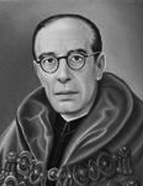

According to Gizlene Neder, Merêa's departure from Coimbra for the University of Lisbon, where he stayed from 1924 to 1931, was evidence of a certain academic isolation and discomfort with Coimbra. The researcher hypothesised that the historian had a conservative political ideology with a strong Catholic influence, although he kept a healthy distance from the ideological intricacies of Salazarism (Neder, G., "História das ideias..." [History of the ideas...], 2012, pp. 22-23). However, little can be said about Paulo Merêa's political stance, as the historian did not allow his opinions to surface in his written work. Mário Júlio de Almeida Costa wrote that Merêa had never allowed himself to be seduced by "fashionable ideologies", largely because of the liberal thinkers he had studied, and had always remained sceptical about politics. An example of one of the liberal thinkers worked on was Alexandre Herculano, whose personal conception of liberalism was studied by Merêa (Merêa, P., “O Liberalismo de Herculano” [Herculano's Liberalism], Estudos de Filosofia Jurídica... [Studies on Legal Philosophy], 2004, pp. 281-296). Paulo Merêa believed that "the supreme path to freedom was culture, as he felt it led to the highest form of independence". Nevertheless, Almeida Costa highlighted Merêa's religious and conservative nature, noting his "profound Catholicism, with hints of mysticism, though admittedly 'troubled' by the liturgical innovations he observed" (Costa, M. J. A., “Prefácio” [Preface]. Merêa, P., Estudos de Filosofia Jurídica..., 2004, p. 9).
According to A. M. Hespanha ("Historiografia...", 1982, p. 807), M. P. Merêa's work can be divided into four fundamental phases. The first, from 1915 to 1923, focused on the history of second scholastic political thought; the second, from 1923 to 1943, was devoted to the history of the feudal constitution; the third, from 1943 to 1951, focused on the history of Visigothic law, particularly the "personality" and "territoriality" of Visigothic legislation; and the fourth, from 1951 to 1961, was the phase in which he outlined legal education in the 19th century. There was no single field of study that could encompass the historian's entire body of work. In the words of Mário Júlio Almeida Costa, his work extended "into the fields of the history and philosophy of law, comparative legislation and even non-legal areas such as philology, diplomacy and palaeography" (Costa, M. J. A., “Evocação dos Profs. Doutores…” [In remembrance of Prof.], 1987, pp. 233-234).
This work is financed by national funds through FCT - Foundation for Science and Technology, I.P, in the scope of the projects UIDB/04311/2020 and UIDP/04311/2020.
